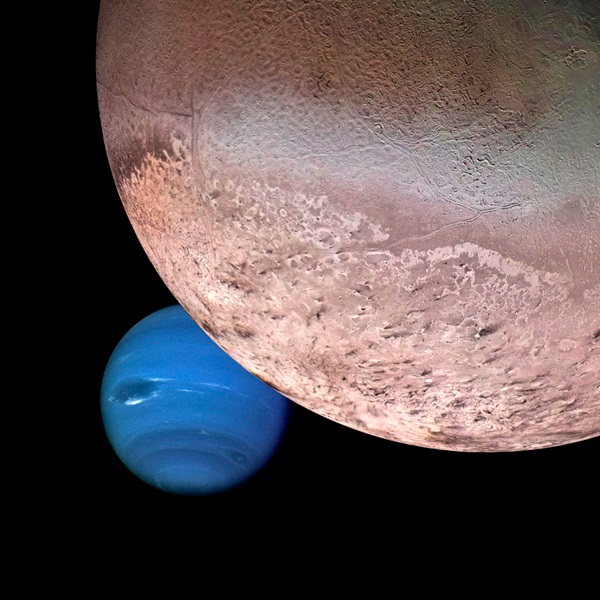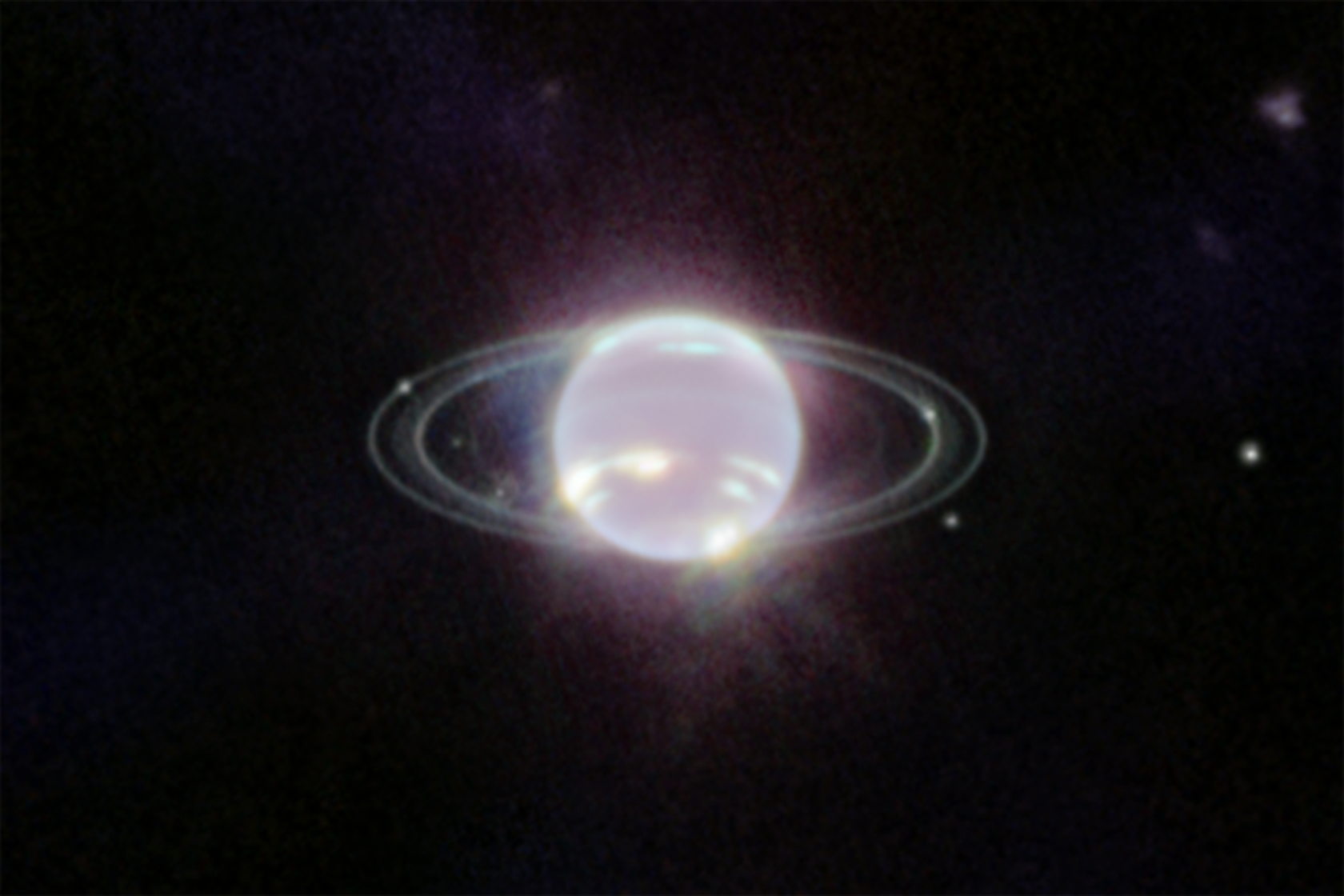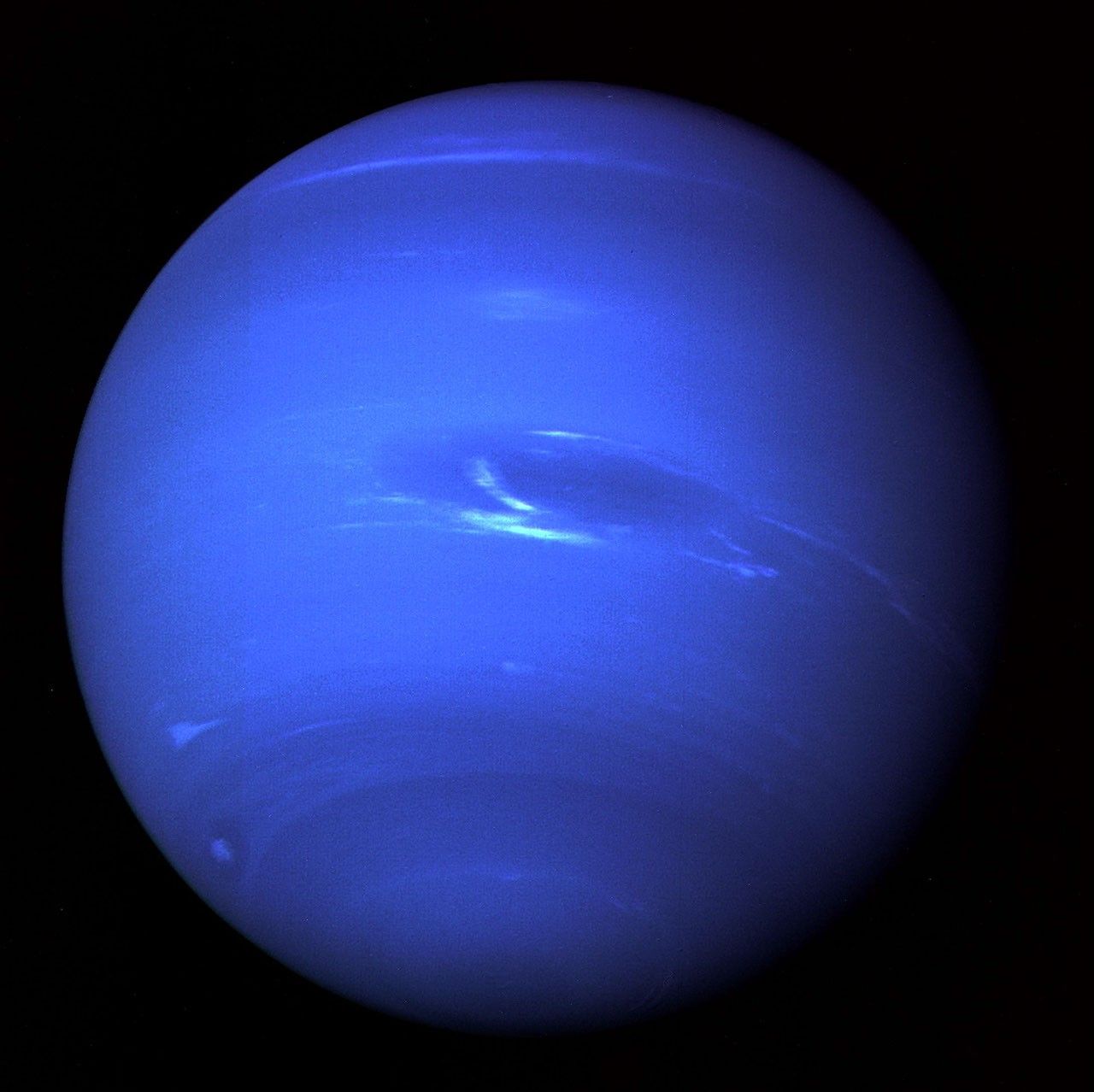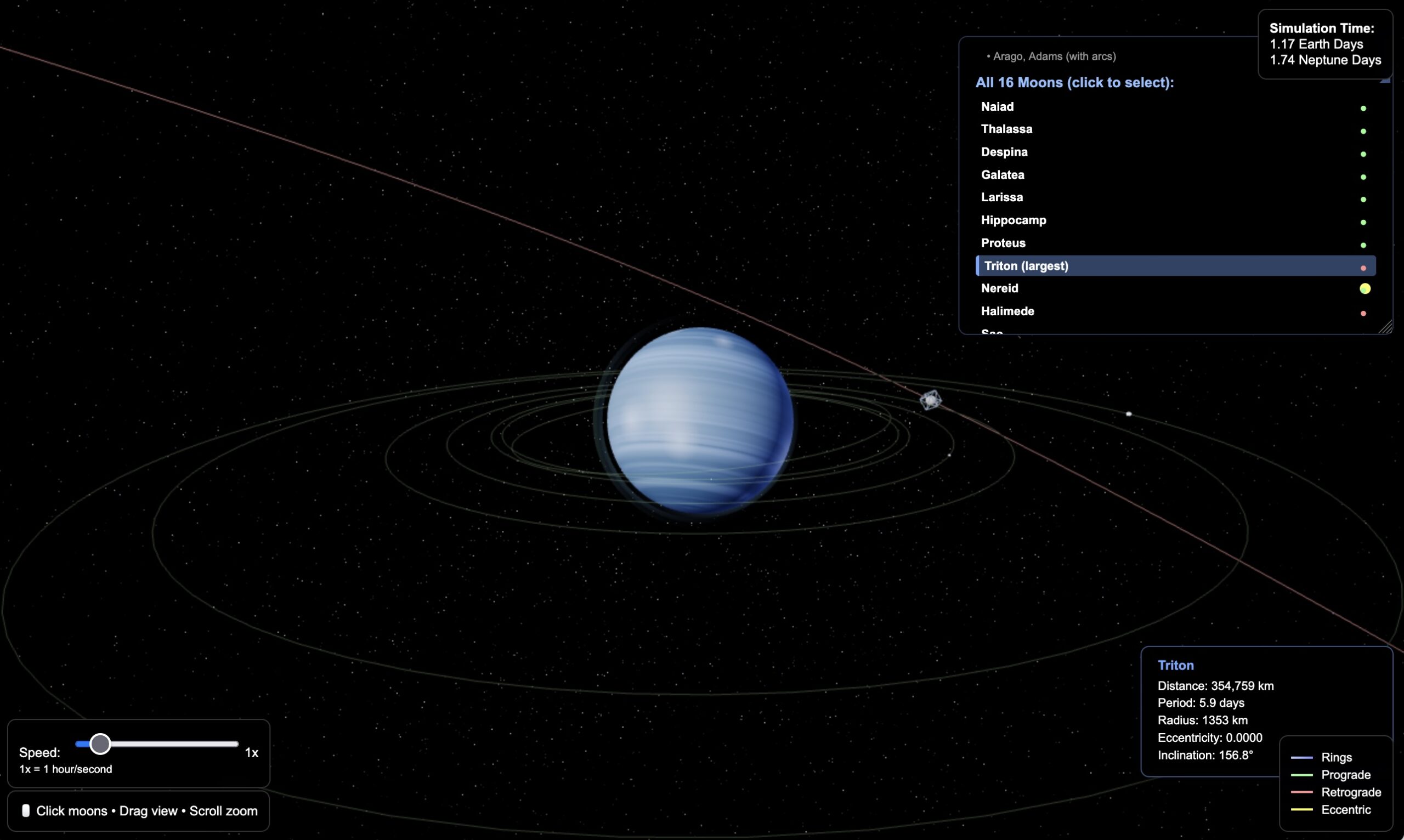Neptune is a fascinating system, continually forging the outer edges of our solar system. The gas giant’s orbit is littered with debris, dust and objects that travel through the Oort Cloud and into the Kuiper Belt and get caught in the gravity of the huge frozen gas giant. With a day lasting about 16 hours, and a size about 57 Earths, this means that the wind speed on Neptune is absolutely incredible due to the Coriolis effect. They winds are actually supersonic, often exceeding 1,100 miles per hour. This suggests complex gravitational and magnetic harmonics that we don’t understand yet. The Great Dark Spot is a massive storm system observed on Neptune that was discovered during the voyager 2 flyby in 1989. This is believed to be a 1,500 mph system that forms and reforms sometimes in multiple places, according to Hubble’s images.
Neptune Orbital Simulator
- Accurate 3D orbital paths for the moons
- UI objects with moon orbit visualizations
- Ring visualizations.
- Size is slightly adjusted; some of the smaller moons are made 3-5x larger so they are visible.
- Mobile and Desktop experiences are different (limited touch screen support, sorry, didn’t realize until I tested)
The UI is pretty snazzy for a quick prototype, the speed slider works well, the planets can be selected, though some are missing or just hard to find, the camera works and you can see rings, though they are inaccurate, which I am working on. All of the moon orbits are Keplerian, in other words they won’t evolve over time; this is meant to be more of a visual aid for the system. You get a great sense of why Triton is probably a captured moon/object from the Kuiper Belt!
Major Moon

Triton
- Radius: 1,353 km (7th largest moon in Solar System)
- Orbital Distance: 354,759 km
- Orbital Period: 5.88 days (retrograde)
- Discovery: 1846 by William Lassell
- Key Facts:
- Only large moon with retrograde orbit
- Likely a captured Kuiper Belt object
- Geologically active with nitrogen geysers
- Thin atmosphere (mostly nitrogen)
- Surface temperature: -235°C
- Orbiting backward, slowly spiraling toward Neptune
Inner Regular Moons
These moons orbit within Neptune’s ring system
Naiad
- Radius: 33 km | Distance: 48,227 km | Period: 7.06 hours
- Innermost moon, orbits in under 8 hours
Thalassa
- Radius: 40 km | Distance: 50,075 km | Period: 7.48 hours
- Discovered by Voyager 2 in 1989
Despina
- Radius: 78 km | Distance: 52,526 km | Period: 7.98 hours
- Shepherds Neptune’s Le Verrier ring
Galatea
- Radius: 87 km | Distance: 61,953 km | Period: 10.29 hours
- Shepherds Adams ring arcs
Larissa
- Radius: 97 km | Distance: 73,548 km | Period: 13.31 hours
- Fourth largest inner moon
Hippocamp
- Radius: 17 km | Distance: 105,283 km | Period: 22.98 hours
- Smallest known moon, discovered 2013
- Likely fragment from Proteus impact
Proteus
- Radius: 210 km | Distance: 117,647 km | Period: 26.86 hours
- Largest regular moon
- Irregular shape despite large size
- Second-largest Neptunian moon overall
Irregular Outer Moons
Likely captured objects with unusual orbits
Nereid
- Radius: 170 km | Distance: 5,513,818 km | Period: 360 days
- Notable: Most eccentric orbit (e=0.75) of any major moon
- Discovered 1949 by Gerard Kuiper
Halimede
- Radius: 31 km | Distance: 16,611,000 km | Period: 1,874 days
- Retrograde orbit, discovered 2002
Sao
- Radius: 22 km | Distance: 22,228,000 km | Period: 2,912 days
- Prograde irregular, discovered 2002
Laomedeia
- Radius: 21 km | Distance: 23,567,000 km | Period: 3,171 days
- Prograde irregular, discovered 2002
Psamathe
- Radius: 20 km | Distance: 48,096,000 km | Period: 25 years
- Retrograde, enormous orbital distance
- Discovered 2003
Neso
- Radius: 30 km | Distance: 49,285,000 km | Period: 26.7 years
- Record: Farthest moon from its planet in Solar System
- Takes over quarter-century to complete one orbit
- Discovered 2002
S/2002 N5
- Radius: ~15 km | Distance: ~23,000,000 km | Period: ~8 years
- Provisional designation, prograde orbit
S/2021 N1
- Radius: ~14 km | Distance: ~25,000,000 km | Period: ~9 years
- Newest discovery, retrograde orbit
Quick Facts
Orbital Characteristics
- 7 Regular Moons: Orbit close to Neptune’s equatorial plane
- 9 Irregular Moons: Captured objects with tilted, eccentric orbits
- 5 Retrograde Moons: Orbit backward (Triton, Halimede, Psamathe, Neso, S/2021 N1)
- Orbital Periods: Range from 7 hours (Naiad) to 27 years (Neso)
Discovery Timeline
- 1846: Triton (17 days after Neptune itself)
- 1949: Nereid
- 1989: 6 inner moons (Voyager 2)
- 2002-2003: 5 irregular moons (ground telescopes)
- 2013: Hippocamp (Hubble Space Telescope)
- 2021: S/2021 N1 (latest discovery)
Size Comparison
- Giant: Triton (1,353 km)
- Large: Proteus (210 km), Nereid (170 km)
- Medium: Larissa (97 km), Galatea (87 km), Despina (78 km)
- Small: All others under 50 km radius
- Tiny: Hippocamp (17 km), S/2021 N1 (14 km)
Interesting Moon Facts
Triton’s Doom: Orbiting backward, Triton is slowly spiraling inward and will be destroyed in ~3.6 billion years
Hippocamp’s Origin: Likely blasted off Proteus by a comet impact
Extreme Orbits: Neso takes 27 years to orbit once, while Naiad completes 3 orbits per Neptune day
Nereid’s Mystery: Unusual orbit suggests it may be a captured object or disturbed by Triton’s capture
Ring Shepherds: Galatea maintains Neptune’s ring arcs through gravitational resonance
Neptune’s Planetary Parameters and Bulk Properties
Neptune’s mass of 1.0243 × 10²⁶ kg (17.147 Earth masses) makes it the third most massive planet in our solar system. It’s just slightly more massive than Uranus despite having a smaller radius. The equatorial radius measures 24,764 km (about 3.883 Earth radii) while the polar radius is 24,341 km, yielding an oblateness of 0.0171 – relatively modest given its 16.11-hour rotation period. This creates a mean density of 1,638 kg/m³, the highest among the giant planets, indicating a substantially different internal composition than Jupiter or Saturn.
The planet’s moment of inertia coefficient (C/MR²) is approximately 0.23, suggesting strong central mass concentration – more than Uranus (0.225) but less than the terrestrial planets. This value, combined with gravitational field measurements, constrains interior models and indicates significant differentiation despite the likely absence of sharp boundaries between layers.
Rotational Dynamics and Angular Momentum
Neptune’s rotation exhibits fascinating complexity. The interior rotation period, determined from periodic radio emissions tied to the magnetic field, is 16.11 ± 0.01 hours. However, atmospheric features show dramatic differential rotation: equatorial clouds rotate with periods around 18 hours, while polar features can have periods as short as 12 hours. This differential rotation gradient of ~6 hours represents the most extreme in the solar system.
The total angular momentum is approximately 2.5 × 10³⁶ kg·m²/s, with the atmospheric contribution being relatively minor despite the extreme wind speeds. The planet’s rotational kinetic energy is about 7.5 × 10²⁹ J, yet atmospheric dynamics extract only a tiny fraction of this for driving the observed winds, highlighting the efficiency of Neptune’s atmospheric heat engine.
Thermodynamic Properties and Energy Balance
Neptune’s effective temperature is 59.3 ± 0.8 K, significantly higher than the 46.6 K equilibrium temperature expected from solar heating alone. This 12.7 K excess corresponds to an internal heat flux of 433 ± 46 mW/m², representing a heat flow ratio (emitted/absorbed) of 2.61 ± 0.28 – the highest among the giant planets relative to their solar input.
The total internal luminosity reaches (5.2 ± 0.5) × 10¹⁵ W, requiring either primordial heat from formation still escaping, ongoing gravitational contraction at a rate of about 2 × 10⁻¹² per year, or phase separation of constituents releasing latent heat. The specific heat capacity varies dramatically with depth: from about 14,300 J/kg·K in the molecular hydrogen envelope to potentially 4,000 J/kg·K in the high-pressure ice mantle where water exists in superionic phases.
Pressure and Density Stratification
The atmospheric pressure at the 1-bar reference level (where we define the “surface”) corresponds to a temperature of about 72 K. Pressure increases dramatically with depth following approximately:
P(r) ≈ P₀ exp[-(r-R₀)g₀/H]
where the scale height H varies from about 19 km in the upper troposphere to effectively zero in the deep interior where the fluid becomes nearly incompressible.
At the molecular-to-metallic hydrogen transition (around 0.6-0.7 planetary radii, ~6 Mbar pressure), density reaches approximately 1,000 kg/m³. The ice-rock boundary, at roughly 0.2-0.3 planetary radii, sees pressures exceeding 200 GPa and densities approaching 5,000 kg/m³. The central core conditions are extreme: pressure possibly reaching 700-800 GPa (7-8 million times Earth’s atmospheric pressure) with densities of 12,000-15,000 kg/m³.
Elastic and Material Properties
Under Neptune’s interior conditions, materials exhibit exotic properties. Water ice transforms through multiple high-pressure phases: Ice VII above 2 GPa, Ice X above 70 GPa, and ultimately superionic ice XVIII above ~100 GPa and 2,000 K, where oxygen atoms form a solid lattice while hydrogen ions flow freely, creating an electrically conducting “hot ice.”
The bulk modulus varies dramatically through the planet: from essentially zero in the low-density atmosphere to about 10 GPa in the molecular envelope, jumping to ~300 GPa in the ice mantle, and potentially exceeding 1,000 GPa in the rocky core. These variations create complex seismic wave propagation characteristics – compression waves would travel at speeds ranging from 1 km/s in the outer envelope to potentially 15 km/s in the core.
Gravitational Field Harmonics
Beyond the dominant J₂ and J₄ terms, Neptune’s gravitational field shows measurable harmonics up to degree 6. The normalized coefficients are:
- J₂ = (3,411 ± 10) × 10⁻⁶
- J₄ = (-33 ± 3) × 10⁻⁶
- J₆ = (5 ± 2) × 10⁻⁶
These values, particularly the J₄/J₂ ratio of -0.0097, deviate from predictions of uniform rotation, indicating either deep zonal flows extending thousands of kilometers into the interior or compositional anomalies. The gravitational Love number k₂₂ ≈ 0.11 suggests the planet responds to tidal forces as a partially fluid body with significant rigidity in its deep interior.
Transport Properties
Thermal conductivity varies by orders of magnitude through Neptune’s interior. In the molecular envelope, it’s dominated by convection with an effective conductivity around 0.1-1 W/m·K. In the metallic hydrogen layer, electronic thermal conductivity jumps to ~1,000 W/m·K. The superionic ice mantle has intermediate values around 10-100 W/m·K, with the conducting protons enhancing heat transport.
Electrical conductivity shows even more dramatic variation: essentially zero in the molecular atmosphere, jumping to ~10⁴ S/m in the metallic hydrogen layer, and surprisingly high values of 100-1,000 S/m in the superionic ice mantle due to mobile protons. This conductivity profile is crucial for magnetic field generation through dynamo action.
Kinematic viscosity ranges from about 10⁻⁵ m²/s in the upper atmosphere to effectively infinite in the solid core, with complex non-Newtonian behavior in the high-pressure ice phases where viscosity depends strongly on strain rate.
Phase Transitions and Critical Points
Neptune’s interior crosses multiple phase boundaries. The hydrogen-helium mixture reaches its critical point around 2,000 K and 1.5 Mbar, above which no distinction exists between liquid and gas phases. Deeper, hydrogen undergoes a gradual transition to metallic conductivity rather than a sharp first-order transition, occurring over a pressure range of roughly 1-4 Mbar.
Water’s phase diagram under Neptune conditions is extraordinary. The critical point (647 K, 22 MPa under Earth conditions) becomes irrelevant as water enters exotic phases: Ice VII’s triple point with liquid water and Ice VI occurs at 355 K and 2.2 GPa. The transition to superionic ice occurs around 2,000 K and 50 GPa, where water’s ionic conductivity increases by orders of magnitude.
Compressibility and Equation of State
Neptune’s bulk compressibility varies from highly compressible in the outer atmosphere (κ ~ 1/P) to nearly incompressible in the deep interior (κ ~ 10⁻¹² Pa⁻¹). The equation of state must account for:
- Non-ideal gas effects and hydrogen-helium immiscibility
- Pressure ionization and dissociation
- Quantum effects including zero-point energy
- Thermal pressure from ionic motion in superionic phases
- Exchange interactions in the degenerate core
Modern models use complex equations of state like REOS3 for water, SCvH for hydrogen-helium mixtures, and ANEOS for rocky materials, coupled together through mixing rules and phase equilibria calculations.
Spectroscopic Analysis and Atmospheric Composition
Neptune’s atmosphere presents a complex spectroscopic signature dominated by methane absorption bands, particularly strong in the red and near-infrared regions around 619, 727, and 890 nanometers. This methane absorption gives Neptune its distinctive azure color, as the atmosphere preferentially scatters blue light while absorbing longer wavelengths. Beyond methane, which comprises about 2-3% of the atmosphere by volume, we detect hydrogen (about 80%) and helium (about 19%) through their pressure-induced absorption features in the infrared.
Advanced spectroscopic observations have revealed trace amounts of hydrogen deuteride (HD), allowing us to measure the D/H ratio at approximately 4.1 × 10⁻⁵, which provides crucial constraints on solar system formation models. We’ve also detected ethane, acetylene, and hydrogen cyanide through high-resolution infrared spectroscopy, products of methane photochemistry in the upper atmosphere. The stratosphere shows unexpected temperature variations that correlate with hydrocarbon abundances, suggesting complex photochemical-dynamical coupling.
Neptune’s Atmospheric Dynamics and Structure
Neptune’s atmosphere is the most dynamically active in the solar system relative to its energy input. Despite receiving only about 40% of the sunlight that Uranus gets, Neptune radiates approximately 2.6 times the energy it receives from the Sun. This internal heat flux drives powerful atmospheric dynamics, including winds reaching supersonic speeds of up to 2,100 km/h in the equatorial region, moving retrograde relative to the planet’s rotation.
The atmosphere exhibits a fascinating vertical structure with a troposphere extending from about 5 bar pressure level up to the tropopause at roughly 0.1 bar, where temperatures reach a minimum of about 51 K. Above this, the stratosphere shows surprising temperature inversions, reaching up to 170 K at the 10⁻⁶ bar level, likely driven by methane-induced greenhouse effects and hydrocarbon haze heating.
Neptune’s Gravitational Field and Interior Structure
Neptune’s gravitational field, precisely measured by Voyager 2 and refined through long-term tracking of its moons, reveals significant departures from a simple oblate spheroid. The planet’s J₂ gravitational moment is 3,411 × 10⁻⁶, with J₄ at -33 × 10⁻⁶, indicating substantial mass concentration toward the center but with a more complex density distribution than simple models predict.
These gravitational harmonics, combined with the observed heat flow, suggest a three-layer interior structure: a small rocky core of about 1.2 Earth masses at temperatures possibly exceeding 5,000 K and pressures around 700 GPa, surrounded by a mantle of hot, dense “ices” (actually a superionic phase of water, methane, and ammonia under extreme pressure), and an outer hydrogen-helium envelope. The transition between these layers appears gradual rather than sharp, indicating significant compositional mixing.
Neptune’s Magnetic Field Complexity
Neptune’s magnetic field is among the most peculiar in the solar system, with a dipole moment of 2.2 × 10¹⁷ T·m³, tilted about 47° from the rotation axis and offset from the planet’s center by approximately 0.55 Neptune radii. This unusual configuration suggests the field originates in the planet’s mantle rather than the core, likely generated by convective motions in the electrically conducting ionic ocean of water, methane, and ammonia.
The field shows strong quadrupole and octupole components, with the quadrupole moment being about 75% as strong as the dipole. This multipolar structure creates a complex magnetosphere that undergoes dramatic reconfigurations as the planet rotates, causing the magnetotail to twist into a corkscrew shape unique in the solar system. The magnetic field strength at the cloud tops varies from about 0.1 to 1.0 Gauss depending on location.
Extra-Galactic Context and Comparative Planetology
While Neptune itself isn’t directly connected to extra-galactic objects, studying it provides crucial calibration for understanding exoplanets, particularly the numerous “sub-Neptune” and “mini-Neptune” class planets discovered by Kepler and TESS. Neptune’s mass-radius relationship, atmospheric escape rates, and spectroscopic signatures serve as benchmarks for interpreting observations of planets orbiting other stars.
The detection methods we’ve refined studying Neptune’s atmosphere, particularly transmission spectroscopy techniques and phase curve analysis, directly inform how we analyze atmospheres of exoplanets during transits. Neptune’s atmospheric metallicity, enriched by about 30-50 times solar values, provides insights into planetary migration and the distribution of volatiles in protoplanetary disks, concepts we now apply to understanding exoplanetary systems throughout the galaxy.
The relationship between Neptune’s internal heat, atmospheric dynamics, and magnetic field generation offers a natural laboratory for testing theories about ice giant formation and evolution that we can apply to the surprising abundance of Neptune-sized exoplanets, which appear to be among the most common planetary types in the galaxy despite being relatively rare in our own solar system.
Neptune as a Guide to the Universe
The Exoplanet Revolution and Neptune’s Unexpected Role in finding far-away planets
When the Kepler Space Telescope began its planet-hunting mission in 2009, astronomers expected to find solar systems that looked like ours—rocky planets close in, gas giants farther out. Instead, they discovered that Neptune-sized worlds are among the most common planets in the galaxy, yet they’re relatively rare in our own solar system. This “Neptune desert” in our neighborhood makes our ice giant extraordinarily valuable as the only nearby laboratory for understanding a dominant planetary class throughout the cosmos.
Neptune as a Calibration Standard
Mass-Radius Relationships
Neptune provides a critical data point in the mass-radius diagram that astronomers use to classify exoplanets. With its precise mass of 17.15 Earth masses and radius of 3.88 Earth radii, Neptune anchors the transition zone between “super-Earths” and “sub-Neptunes”—categories that didn’t even exist before exoplanet discoveries. When astronomers detect a planet with similar mass-radius characteristics orbiting a distant star, they can infer it likely has a similar composition: a rocky core wrapped in a thick envelope of water, methane, and hydrogen.
Atmospheric Benchmarks
Neptune’s well-studied atmospheric composition—80% hydrogen, 19% helium, and trace amounts of methane—serves as a reference spectrum for interpreting exoplanet atmospheres. When the James Webb Space Telescope analyzes the atmosphere of an exo-Neptune passing in front of its star, scientists compare those absorption lines directly to Neptune’s known spectrum to identify molecular species and atmospheric structure.
Transmission Spectroscopy Techniques
The methods we’ve perfected studying Neptune’s atmosphere from Earth and spacecraft are identical to those used for exoplanets. When Neptune transits the Sun as viewed from the outer solar system, its atmosphere creates a transmission spectrum—exactly what we observe when exoplanets transit their stars. The distinctive methane absorption features at 1.4 and 2.3 microns that give Neptune its blue color are the same signatures we search for in sub-Neptune exoplanets.
Neptune has taught us that these spectral features can be modified by:
- High-altitude hazes that mute absorption features
- Cloud layers at different pressure levels that alter the effective atmospheric depth
- Photochemical products that create unexpected absorption bands
- Temperature inversions that flip expected line strengths
Internal Heat and Atmospheric Dynamics
Neptune’s surprising 2.6:1 ratio of emitted to absorbed energy has revolutionized our understanding of ice giant energy budgets. This discovery directly influences how we interpret:
Phase Curves of Exoplanets
As exoplanets orbit their stars, we measure brightness variations that reveal heat transport from day to night sides. Neptune’s powerful internal heat source teaches us that ice giants can maintain active atmospheres even with minimal stellar heating—crucial for understanding exoplanets in the “Neptune desert” close to their stars or frozen exo-Neptunes in distant orbits.
Wind Speed Predictions
Neptune’s supersonic winds, powered by internal heat rather than sunlight, suggest that even weakly irradiated exo-Neptunes might have dramatic atmospheric dynamics. This has led to new models predicting that “hot Neptunes” close to their stars might have wind speeds exceeding 5,000 km/h.
Magnetic Field Generation and Habitability
Neptune’s offset, tilted magnetic field, generated in its ionic water-ammonia mantle rather than its core, has revealed an entirely different mode of planetary magnetism. This discovery impacts:
Exoplanet Habitability Zones
For potentially habitable moons around exo-Neptunes, understanding the magnetic environment is crucial. Neptune shows us that ice giants can generate strong, complex magnetic fields that could protect moons from stellar radiation—or subject them to intense particle bombardment depending on orbital geometry.
Radio Emissions
Neptune’s auroral radio emissions, modulated by its tilted magnetic field, produce a distinctive pattern we can now search for in radio observations of exoplanets. The Square Kilometre Array and future radio telescopes will hunt for these signals as direct evidence of exoplanetary magnetic fields.
Formation and Migration Models
The Metallicity Problem
Neptune’s atmosphere is enriched in heavy elements by 30-50 times solar values, yet its overall mass suggests it formed beyond the solar system’s original ice line. This paradox has reshaped planet formation theories, suggesting that:
- Planets can dramatically migrate from their formation locations
- Ice giants efficiently capture solid materials during formation
- Atmospheric enrichment continues long after initial accretion
These insights now explain why many exo-Neptunes orbit impossibly close to their stars—they migrated there after forming in colder regions.
The Compositional Gradient
Neptune’s apparent three-layer structure (core, ionic ocean, atmosphere) with gradual rather than sharp boundaries has become the template for understanding intermediate-mass planets. This model explains the diversity of exoplanet densities: slight variations in formation conditions can produce dramatically different internal structures and observable properties.
Future Technological Enhancements
Direct Imaging Targets
As we develop technology to directly image exoplanets, Neptune serves as the test case. Its spectrum, phase function, and polarization signature—measured in exquisite detail—are the templates for what we expect to see when we image exo-Neptunes around other stars. The Roman Space Telescope and Extremely Large Telescopes will search for Neptune analogs using filters and techniques optimized based on our ice giant’s properties.
Atmospheric Escape and Evolution
Neptune’s current atmospheric escape rate, measured by its extended hydrogen corona, calibrates models for how sub-Neptunes evolve. Many close-in exoplanets likely started as Neptune-mass worlds but lost their atmospheres to become super-Earths. Understanding Neptune’s current mass loss rate and magnetic protection helps us reverse-engineer this evolutionary process.
The Broader Cosmic Context
Neptune represents a fundamental planetary state—worlds massive enough to capture hydrogen but not massive enough to become gas giants like Jupiter. This “ice giant” configuration appears to be a sweet spot in planetary formation, explaining why Neptune-mass planets are so common throughout the galaxy.
Every detail we learn about Neptune—from the dynamics of its Great Dark Spot to the composition of its rings, from its unusual magnetic field to its internal heat source—becomes a data point for understanding thousands of similar worlds orbiting other stars. In this way, Neptune has transcended its role as merely the eighth planet from our Sun. It has become a cosmic Rosetta Stone, helping us decode the properties of planets throughout the universe.
As we stand on the threshold of characterizing potentially habitable worlds around other stars, many of which orbit in systems with Neptune-like planets, our ice giant becomes even more relevant. The same physics governing Neptune’s atmosphere, interior, and magnetosphere will shape the environments of countless exoplanets and their moons. In studying Neptune, we’re not just exploring the edge of our solar system—we’re unlocking the secrets of planetary systems throughout the cosmos.

Neptune, once the frontier of our planetary system, has become our window into understanding the most common type of planet in the universe. As we continue to study this dynamic ice giant with increasingly sophisticated instruments, each discovery ripples outward, informing our understanding of worlds dozens, hundreds, and thousands of light-years away. In the grand story of comparative planetology, Neptune has evolved from a distant, mysterious world to an essential key for decoding the nature of planets throughout the galaxy.
References and Additional Resources
Primary Scientific Sources
NASA Resources
- NASA Neptune Fact Sheet: https://nssdc.gsfc.nasa.gov/planetary/factsheet/neptunefact.html
- Comprehensive physical and orbital parameters
- NASA Solar System Exploration – Neptune: https://solarsystem.nasa.gov/planets/neptune/overview/
- Latest discoveries and mission updates
- JPL Solar System Dynamics: https://ssd.jpl.nasa.gov/
- Precise ephemeris data and orbital elements
- NASA Image Gallery – Neptune: https://www.nasa.gov/subject/3160/neptune/
- High-resolution images from various missions
Space Agency Databases
- ESA Space Science – Neptune: https://www.esa.int/Science_Exploration/Space_Science
- Planetary Data System (PDS): https://pds.nasa.gov/
- Raw data from planetary missions
- Minor Planet Center: https://www.minorplanetcenter.net/
- Latest moon discoveries and designations
Voyager 2 Mission Resources
Mission Documentation
- Voyager Mission Status: https://voyager.jpl.nasa.gov/
- Current position and ongoing data transmission
- Voyager 2 Neptune Encounter Press Kit (1989): Available through NASA Technical Reports Server
- “Voyager 2 at Neptune: Imaging Results” – Smith et al., Science, Vol. 246, 1989
- JPL Voyager Image Archive: https://voyager.jpl.nasa.gov/galleries/images-voyager-took/
Academic Papers and Research
Foundational Papers
- “The Discovery of Neptune” – Standish, E.M. & Nobili, A.M. (1997), Baltic Astronomy, Vol. 6
- “Neptune’s Story” – Cruikshank, D.P. (1995), Science, Vol. 267
- “The Atmosphere of Neptune” – Broadfoot et al. (1989), Science, Vol. 246
- “Neptune’s Ring System” – Porco et al. (1995), Neptune and Triton, University of Arizona Press
Recent Research (2020-2025)
- “Triton: Fascinating Moon, Likely Ocean World” – Hendrix et al. (2024), Astrobiology
- “Neptune’s Great Dark Spot: New Observations” – Wong et al. (2023), Icarus
- “Ring Dynamics and Moon Interactions at Neptune” – French et al. (2024), Astronomical Journal
- “Detection of Neptune’s New Moon S/2021 N1” – Sheppard et al. (2022), Minor Planet Electronic Circulars
Books and Comprehensive Texts
Recommended Reading
- “Neptune and Triton” (1995) – Dale P. Cruikshank (Editor), University of Arizona Press
- The definitive post-Voyager scientific reference
- “Ice Giants: Neptune and Uranus” (2020) – Patrick Irwin, Reaktion Books
- Accessible overview of ice giant science
- “The Planet Neptune: An Historical Survey Before Voyager” (1996) – Patrick Moore & Garry Hunt
- “Planets and Moons” (2022) – Imke de Pater & Jack J. Lissauer, Cambridge University Press
- Graduate-level planetary science textbook
Educational Resources
University Courses and Lectures
- MIT OpenCourseWare – Planetary Science: https://ocw.mit.edu/
- Coursera – The Science of the Solar System: California Institute of Technology
- Yale Open Courses – Frontiers and Controversies in Astrophysics
Interactive Tools
- NASA’s Eyes on the Solar System: https://eyes.nasa.gov/
- Real-time 3D solar system visualization
- Stellarium Web: https://stellarium-web-engine.org/
- View Neptune’s current position
- JPL Horizons System: https://ssd.jpl.nasa.gov/horizons/
- Calculate precise positions and ephemerides
Observatory Resources
Ground-Based Observations
- Keck Observatory Neptune Studies: https://www.keckobservatory.org/
- ESO Very Large Telescope Neptune Observations: https://www.eso.org/public/
- Hubble Space Telescope Neptune Archive: https://hubblesite.org/
- James Webb Space Telescope Neptune Images: https://webbtelescope.org/
Historical Archives
Discovery and Early Observations
- Royal Astronomical Society Historical Archives: https://ras.ac.uk/library-archives
- Original correspondence about Neptune’s discovery
- Paris Observatory Digital Library: https://bibnum.obspm.fr/
- Le Verrier’s original calculations
- Cambridge University Library – Adams Papers: https://www.lib.cam.ac.uk/
- John Couch Adams’ Neptune predictions
Multimedia Resources
Documentaries and Videos
- “The Farthest: Voyager in Space” (2017) – PBS Documentary
- **”Planets” (2019) – BBC Series, Episode on Ice Giants
- NASA Goddard YouTube Channel: Neptune-related content
- “The Grand Tour: Voyager’s Journey” – JPL Educational Series
Podcasts
- Planetary Radio: Episodes on Neptune and Voyager 2
- NASA’s Gravity Assist: Ice giant exploration episodes
- The Planetary Society Podcast: Neptune mission proposals
Future Missions and Proposals
Mission Concepts
- Neptune Odyssey Mission Concept: Planetary Science Decadal Survey 2023-2032
- Trident Mission Proposal: https://www.jpl.nasa.gov/missions/trident
- Ice Giant Mission Studies: NASA/ESA collaboration documents
- Argo Mission Concept: New Frontiers program proposal
Data and Ephemeris Tools
Calculation Resources
- IMCCE Ephemeris Generator: https://www.imcce.fr/
- Astronomical Almanac Online: https://asa.hmnao.com/
- USNO Data Services: https://www.usno.navy.mil/USNO
Professional Organizations
Relevant Scientific Bodies
- Division for Planetary Sciences (AAS): https://dps.aas.org/
- International Astronomical Union: https://www.iau.org/
- The Planetary Society: https://www.planetary.org/
- European Planetary Science Congress: https://www.epsc.eu/
Citizen Science Projects
Participate in Neptune Research
- Zooniverse – Planet Hunters: Search for exoplanets similar to Neptune
- JunoCam Planning: Help plan observations of giant planets
- Backyard Worlds: Discover new objects in the outer solar system
Technical Specifications
Atmosphere and Composition Data
- Goddard Space Flight Center Fact Sheets: Atmospheric models and spectra
- Planetary Atmospheres Node (PDS): Spectroscopic databases
- VIMS Data Archive: Composition and temperature profiles
Image Credits and Archives
High-Resolution Image Sources
- Planetary Photojournal: https://photojournal.jpl.nasa.gov/
- USGS Astrogeology Science Center: https://astrogeology.usgs.gov/
- ESA/Hubble Image Archive: https://esahubble.org/images/
Related Topics for Further Exploration
Comparative Planetology
- Uranus Resources: Understanding Neptune’s ice giant twin
- Kuiper Belt Objects: Neptune’s gravitational influence on TNOs
- Exo-Neptunes: Neptune-like planets in other solar systems
- Planetary Ring Systems: Comparative studies across the solar system
Last Updated: 2025 | Compiled for elliottelford.com
For corrections, updates, or suggested additions to this resource list, please contact through the website.


